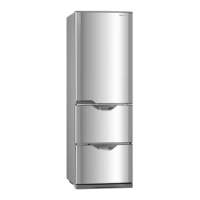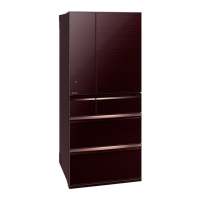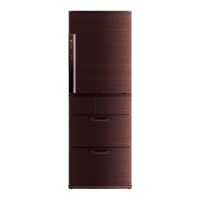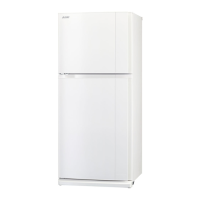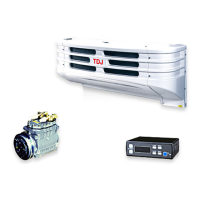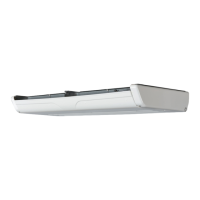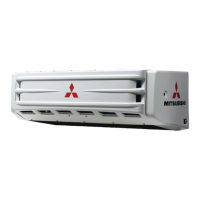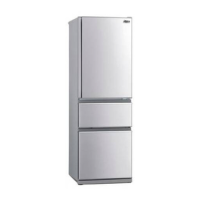
Do you have a question about the Mitsubishi MR-C46B and is the answer not in the manual?
| Brand | Mitsubishi |
|---|---|
| Model | MR-C46B |
| Category | Refrigerator |
| Language | English |
Guidelines for safe unit placement, ventilation, and electrical connections.
Safe handling of electrical plugs, cords, and outlets to prevent accidents.
Proper procedures for moving and installing the refrigerator to avoid injury.
Guidelines for storing food, especially bottles, and closing doors correctly to maintain temperature.
Precautions to prevent injury, such as keeping hands and feet clear of moving parts.
Instructions on avoiding consumption of spoiled or discolored food items.
Guidelines for choosing a suitable location to ensure proper ventilation and cooling.
Steps for safely connecting the power supply and installing an earth wire.
Adjusting the legs for stability and securing the refrigerator against movement.
How to secure the refrigerator to prevent it from toppling during earthquakes.
Guide to setting optimal temperatures for refrigerator and freezer compartments.
Tips for speeding up the refrigerator's cooling process after installation.
Important warnings regarding the refrigerant circuit in non-freon models.
Explanation of the door alarm and troubleshooting steps for its activation.
Instructions for repositioning shelves to maximize storage capacity.
How to utilize and adapt the three-way flexishelf for different food items.
Using the egg tray as both an egg holder and a small items tray.
Advice on placing items to prevent door obstruction and potential damage.
Guidance on adjusting settings to avoid freezing food items, especially in low ambient temperatures.
Information on the LED light's role in enhancing vegetable freshness and vitamin C.
Practical advice for reducing the refrigerator's energy consumption.
Guidelines for using the freezer, including managing frost and water droplets.
Methods to keep food fresh and prevent odors by wiping and wrapping.
Advice on discarding the first few batches of ice for optimal quality.
Guidance on using tap water or filtered water for the ice maker.
Step-by-step instructions for filling the water tank and operating the ice maker.
How to deactivate the automatic ice-making function using the control panel.
Instructions for reactivating the automatic ice-making function.
Key warnings about ice storage, food placement, and detection lever operation.
Identifying and resolving common problems related to ice production and quality.
Essential safety step: unplugging the unit before commencing any cleaning tasks.
Recommended techniques and cleaning agents for various refrigerator parts.
Detailed steps for removing and cleaning shelves and cases in the refrigerator section.
Instructions for safely removing and cleaning ice storage and freezing cases.
Importance of cleaning the door seal to maintain cooling efficiency and prevent leaks.
Instructions for detaching and cleaning various storage pockets and trays.
How to remove and clean the sliding and vegetable cases within the compartment.
Step-by-step guide for safely changing the internal light bulb.
Methods for cleaning the back of the unit, walls, and floor area.
Regularly checking the power cord and plug for damage or signs of overheating.
Procedure for weekly cleaning of the water supply tank and purification filter.
Steps for monthly maintenance of the water pump, pipe, and impeller.
How to perform a rinse cycle to clean the ice making tray using the water supply.
Instructions for preparing the ice maker for extended periods without operation.
Actions to take during a power outage to preserve food and the unit.
Steps for cleaning and preparing the refrigerator for extended periods of inactivity.
Detailed instructions for draining and safely moving the appliance.
Guidelines for safely moving the refrigerator and changing its orientation.
Tips and practices to reduce the refrigerator's electricity consumption.
Checks to perform to ensure the refrigerator's continued performance and safety.
Diagnosing and resolving issues related to insufficient cooling or freezing.
Understanding and managing condensation and frost buildup inside and outside the unit.
Addressing problems with doors not closing properly or becoming difficult to open.
Tips for preventing and eliminating unpleasant odors from food and the refrigerator.
Identifying operational sounds and troubleshooting potential electronic interference.
List of all included accessories for refrigerator, vegetable, and freezer compartments.
Information on model names, corresponding countries, and climatic classifications.
Cautions regarding ambient temperature, food storage during maintenance, and power failures.

